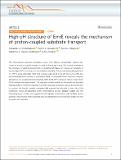High-pH structure of EmrE reveals the mechanism of proton-coupled substrate transport
Author(s)
Shcherbakov, Alexander A; Spreacker, Peyton J; Dregni, Aurelio J; Henzler-Wildman, Katherine A; Hong, Mei
DownloadPublished version (3.120Mb)
Publisher with Creative Commons License
Publisher with Creative Commons License
Creative Commons Attribution
Terms of use
Metadata
Show full item recordAbstract
<jats:title>Abstract</jats:title><jats:p>The homo-dimeric bacterial membrane protein EmrE effluxes polyaromatic cationic substrates in a proton-coupled manner to cause multidrug resistance. We recently determined the structure of substrate-bound EmrE in phospholipid bilayers by measuring hundreds of protein-ligand H<jats:sup>N</jats:sup>–F distances for a fluorinated substrate, 4-fluoro-tetraphenylphosphonium (F<jats:sub>4</jats:sub>-TPP<jats:sup>+</jats:sup>), using solid-state NMR. This structure was solved at low pH where one of the two proton-binding Glu14 residues is protonated. Here, to understand how substrate transport depends on pH, we determine the structure of the EmrE-TPP complex at high pH, where both Glu14 residues are deprotonated. The high-pH complex exhibits an elongated and hydrated binding pocket in which the substrate is similarly exposed to the two sides of the membrane. In contrast, the low-pH complex asymmetrically exposes the substrate to one side of the membrane. These pH-dependent EmrE conformations provide detailed insights into the alternating-access model, and suggest that the high-pH conformation may facilitate proton binding in the presence of the substrate, thus accelerating the conformational change of EmrE to export the substrate.</jats:p>
Date issued
2022-12Department
Massachusetts Institute of Technology. Department of ChemistryJournal
Nature Communications
Publisher
Springer Science and Business Media LLC
Citation
Shcherbakov, Alexander A, Spreacker, Peyton J, Dregni, Aurelio J, Henzler-Wildman, Katherine A and Hong, Mei. 2022. "High-pH structure of EmrE reveals the mechanism of proton-coupled substrate transport." Nature Communications, 13 (1).
Version: Final published version